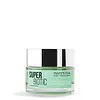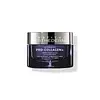What's inside
What's inside
 Key Ingredients
Key Ingredients

 Benefits
Benefits

 Concerns
Concerns

 Ingredients Side-by-side
Ingredients Side-by-side

Water
Skin ConditioningGlycerin
HumectantCoco-Caprylate
EmollientSorbitan Stearate
EmulsifyingPropanediol
SolventSaccharomyces/Xylinum/Black Tea Ferment
Skin ConditioningArgania Spinosa Kernel Oil
EmollientPrunus Amygdalus Dulcis Oil
Skin ConditioningCetyl Alcohol
EmollientPrunus Armeniaca Kernel Oil
MaskingButyrospermum Parkii Butter
Skin ConditioningOenothera Biennis Oil
EmollientSqualane
EmollientDecyl Oleate
EmollientPanthenol
Skin ConditioningAlpha-Glucan Oligosaccharide
CleansingChondrus Crispus Extract
Skin ConditioningSodium Polyglutamate
HumectantHippophae Rhamnoides Fruit Extract
Skin ConditioningAnnona Cherimola Fruit Extract
Skin ConditioningAlbatrellus Confluens Extract
HumectantPhospholipids
Skin ConditioningChlorella Vulgaris Extract
Skin ConditioningUndaria Pinnatifida Extract
Skin ConditioningSphingolipids
EmollientRosa Centifolia Flower Extract
AstringentRosa Damascena Flower Oil
MaskingRosa Damascena Flower Water
MaskingRosmarinus Officinalis Leaf Extract
AntimicrobialPantolactone
HumectantAscorbyl Palmitate
AntioxidantLecithin
EmollientXanthan Gum
EmulsifyingTocopherol
AntioxidantHelianthus Annuus Seed Oil
EmollientSodium Hydroxide
BufferingSodium Citrate
BufferingBiosaccharide Gum-1
HumectantCitric Acid
BufferingPhenylpropanol
MaskingHydrogenated Palm Glycerides Citrate
EmollientPentylene Glycol
Skin ConditioningCarbomer
Emulsion StabilisingPhenethyl Alcohol
MaskingPhenoxyethanol
PreservativeDisodium EDTA
Ethylhexylglycerin
Skin ConditioningPotassium Sorbate
PreservativePotassium Benzoate
PreservativeSodium Benzoate
MaskingSodium Dehydroacetate
PreservativeCI 42090
Cosmetic ColorantWater, Glycerin, Coco-Caprylate, Sorbitan Stearate, Propanediol, Saccharomyces/Xylinum/Black Tea Ferment, Argania Spinosa Kernel Oil, Prunus Amygdalus Dulcis Oil, Cetyl Alcohol, Prunus Armeniaca Kernel Oil, Butyrospermum Parkii Butter, Oenothera Biennis Oil, Squalane, Decyl Oleate, Panthenol, Alpha-Glucan Oligosaccharide, Chondrus Crispus Extract, Sodium Polyglutamate, Hippophae Rhamnoides Fruit Extract, Annona Cherimola Fruit Extract, Albatrellus Confluens Extract, Phospholipids, Chlorella Vulgaris Extract, Undaria Pinnatifida Extract, Sphingolipids, Rosa Centifolia Flower Extract, Rosa Damascena Flower Oil, Rosa Damascena Flower Water, Rosmarinus Officinalis Leaf Extract, Pantolactone, Ascorbyl Palmitate, Lecithin, Xanthan Gum, Tocopherol, Helianthus Annuus Seed Oil, Sodium Hydroxide, Sodium Citrate, Biosaccharide Gum-1, Citric Acid, Phenylpropanol, Hydrogenated Palm Glycerides Citrate, Pentylene Glycol, Carbomer, Phenethyl Alcohol, Phenoxyethanol, Disodium EDTA, Ethylhexylglycerin, Potassium Sorbate, Potassium Benzoate, Sodium Benzoate, Sodium Dehydroacetate, CI 42090
Water
Skin ConditioningDiisopropyl Sebacate
EmollientIsostearyl Isostearate
EmollientGlycerin
HumectantPropanediol
SolventC10-18 Triglycerides
EmollientOctyldodecanol
EmollientCera Alba
EmollientDipropylene Glycol
HumectantGlyceryl Stearate Citrate
EmollientMicrocrystalline Cellulose
AbsorbentC12-16 Alcohols
EmollientCocos Nucifera Oil
MaskingXylose
HumectantAcetyl Tetrapeptide-9
Skin ConditioningPalmitoyl Tripeptide-1
Skin ConditioningPalmitoyl Tetrapeptide-7
Skin ConditioningHexapeptide-9
Skin ConditioningButylene Glycol
HumectantParfum
MaskingHydrogenated Lecithin
EmulsifyingPalmitic Acid
EmollientPentylene Glycol
Skin ConditioningCaprylyl Glycol
EmollientMannitol
HumectantCellulose Gum
Emulsion StabilisingSodium Citrate
BufferingPentaerythrityl Tetra-Di-T-Butyl Hydroxyhydrocinnamate
AntioxidantXanthan Gum
EmulsifyingCitric Acid
BufferingPropylene Glycol
HumectantCarbomer
Emulsion StabilisingSodium Lactate
BufferingPolysorbate 20
EmulsifyingEugenol
PerfumingCarnosine
Skin ConditioningDisodium Adenosine Triphosphate
Skin ConditioningLaminaria Digitata Extract
Skin ProtectingMineral Salts
Skin ConditioningWater, Diisopropyl Sebacate, Isostearyl Isostearate, Glycerin, Propanediol, C10-18 Triglycerides, Octyldodecanol, Cera Alba, Dipropylene Glycol, Glyceryl Stearate Citrate, Microcrystalline Cellulose, C12-16 Alcohols, Cocos Nucifera Oil, Xylose, Acetyl Tetrapeptide-9, Palmitoyl Tripeptide-1, Palmitoyl Tetrapeptide-7, Hexapeptide-9, Butylene Glycol, Parfum, Hydrogenated Lecithin, Palmitic Acid, Pentylene Glycol, Caprylyl Glycol, Mannitol, Cellulose Gum, Sodium Citrate, Pentaerythrityl Tetra-Di-T-Butyl Hydroxyhydrocinnamate, Xanthan Gum, Citric Acid, Propylene Glycol, Carbomer, Sodium Lactate, Polysorbate 20, Eugenol, Carnosine, Disodium Adenosine Triphosphate, Laminaria Digitata Extract, Mineral Salts
Ingredients Explained
These ingredients are found in both products.
Ingredients higher up in an ingredient list are typically present in a larger amount.
Carbomer is a polymer of acrylic acid. Its main role is to create a gel consistency.
A high amount of carbomer can cause pilling or balling up of products. Don't worry, most products contain 1% or less of carbomer.
Citric Acid is an alpha hydroxy acid (AHA) naturally found in citrus fruits like oranges, lemons, and limes.
Like other AHAs, citric acid can exfoliate skin by breaking down the bonds that hold dead skin cells together. This helps reveal smoother and brighter skin underneath.
However, this exfoliating effect only happens at high concentrations (20%) which can be hard to find in cosmetic products.
Due to this, citric acid is usually included in small amounts as a pH adjuster. This helps keep products slightly more acidic and compatible with skin's natural pH.
In skincare formulas, citric acid can:
While it can provide some skin benefits, research shows lactic acid and glycolic acid are generally more effective and less irritating exfoliants.
Most citric acid used in skincare today is made by fermenting sugars (usually from molasses). This synthetic version is identical to the natural citrus form but easier to stabilize and use in formulations.
Read more about some other popular AHA's here:
Learn more about Citric AcidGlycerin is already naturally found in your skin. It helps moisturize and protect your skin.
A study from 2016 found glycerin to be more effective as a humectant than AHAs and hyaluronic acid.
As a humectant, it helps the skin stay hydrated by pulling moisture to your skin. The low molecular weight of glycerin allows it to pull moisture into the deeper layers of your skin.
Hydrated skin improves your skin barrier; Your skin barrier helps protect against irritants and bacteria.
Glycerin has also been found to have antimicrobial and antiviral properties. Due to these properties, glycerin is often used in wound and burn treatments.
In cosmetics, glycerin is usually derived from plants such as soybean or palm. However, it can also be sourced from animals, such as tallow or animal fat.
This ingredient is organic, colorless, odorless, and non-toxic.
Glycerin is the name for this ingredient in American English. British English uses Glycerol/Glycerine.
Learn more about GlycerinPentylene glycol is typically used within a product to thicken it. It also adds a smooth, soft, and moisturizing feel to the product. It is naturally found in plants such as sugar beets.
The hydrophilic trait of Pentylene Glycol makes it a humectant. As a humectant, Pentylene Glycol helps draw moisture from the air to your skin. This can help keep your skin hydrated.
This property also makes Pentylene Glycol a great texture enhancer. It can also help thicken or stabilize a product.
Pentylene Glycol also acts as a mild preservative and helps to keep a product microbe-free.
Some people may experience mild eye and skin irritation from Pentylene Glycol. We always recommend speaking with a professional about using this ingredient in your routine.
Pentylene Glycol has a low molecular weight and is part of the 1,2-glycol family.
Learn more about Pentylene GlycolPropanediol is an all-star ingredient. It softens, hydrates, and smooths the skin.
It’s often used to:
Propanediol is not likely to cause sensitivity and considered safe to use. It is derived from corn or petroleum with a clear color and no scent.
Learn more about PropanediolSodium Citrate is the sodium salts of citric acid. In skincare, it is used to alter pH levels and acts as a preservative.
Its main functions are to maintain the pH of a product and neutralize metal ions.
The acidity of our skin is maintained by our glands and skin biome; normal pH level of skin is slightly acidic (~4.75-5.5).
Being slightly acidic allows our skin to create an "acid mantle". This acid mantle is a thin barrier that protects our skin from bacteria and contaminants.
Learn more about Sodium CitrateWater. It's the most common cosmetic ingredient of all. You'll usually see it at the top of ingredient lists, meaning that it makes up the largest part of the product.
So why is it so popular? Water most often acts as a solvent - this means that it helps dissolve other ingredients into the formulation.
You'll also recognize water as that liquid we all need to stay alive. If you see this, drink a glass of water. Stay hydrated!
Learn more about WaterXanthan gum is used as a stabilizer and thickener within cosmetic products. It helps give products a sticky, thick feeling - preventing them from being too runny.
On the technical side of things, xanthan gum is a polysaccharide - a combination consisting of multiple sugar molecules bonded together.
Xanthan gum is a pretty common and great ingredient. It is a natural, non-toxic, non-irritating ingredient that is also commonly used in food products.
Learn more about Xanthan Gum